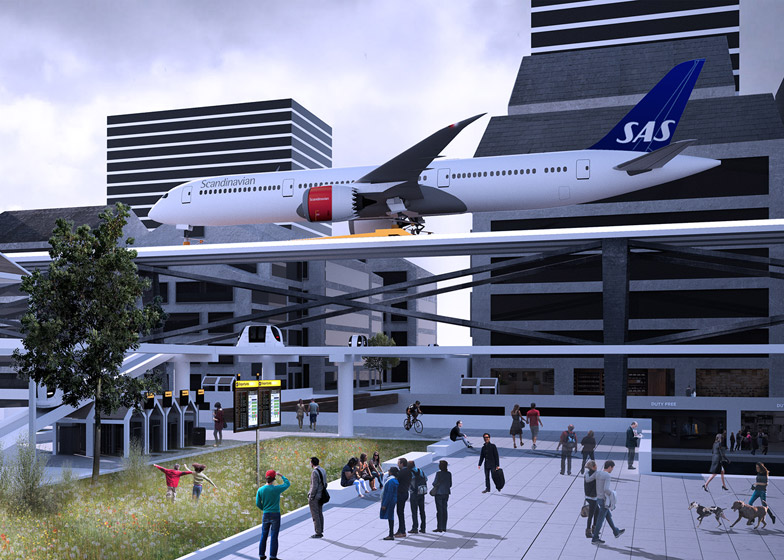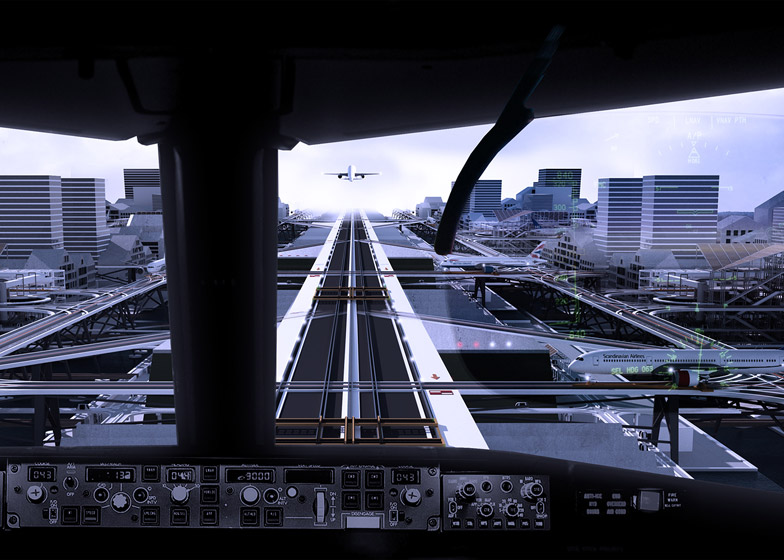Graduate shows 2015: airport runways are raised above the streets and waterways of a new Stockholm city district in this conceptual proposal by Bartlett School of Architecture graduate Alex Sutton (+ slideshow).
The proposal, named Stockholm City Airport/Airport City, envisages a future where commercial aviation becomes more integrated into the fabric of the city rather than being relegated to the outskirts.
To demonstrate this, Sutton proposes a new airport in the Swedish capital where small terminals, city-wide baggage systems and short-length runways slot in around offices, apartment blocks and cultural buildings.
"Travel demand in the aviation industry is set to double by 2030 and continue increasing exponentially into the future," explained Sutton. "In order to satisfy demand and the increasing importance of the airport on local economies, capacity in the industry needs to increase."
"This project uses Stockholm, one of the fastest growing cities in Europe, as a testing ground to establish a fully integrated urban airport as part of a new city district, in a time when aviation technology is such that aircraft and airports could operate from within our cities."
The proposal was developed as part of Unit 16 at the Bartlett School of Architecture in London. Students were asked to develop a utopian dream and consider the steps necessary to make it a reality.
Sutton chose to explore the future of the airport on the basis that the typology has become "mundane and ordinary" due to its ubiquity.
The proposal claims that, by using a system of elevated taxi-track systems to move aeroplanes around the terminals, engines could be disengaged until take-off and would hence produce far less emissions and noise.
"This project responds to the developments that are being made in aviation today, such as the local flight context, take-off and landing, aircraft ground movements, security, passenger processing and ground operations," Sutton said.
"These can inform new architectural opportunities for the airport design, that provide a better relationship between the airport, the city and the traveller," he added.
The airport would be supported by a Personal Rapid Transit (PRT) system – a series of pods that move along rail tracks – so that passengers don't need to drive. These pods would also serve aircraft gates.
Self-service baggage kiosks would be located alongside PRT stations, as part of a smartphone-controlled automated system that removes the stress of carrying luggage around.
"Digital developments such as personal digital bag tags, pre-prepared remotely from the airport, allow passengers to effectively drop-and-go," said Sutton. "The system then uses the digital information to take the bag directly to the relevant aircraft gate, where it will be automatically sorted and loaded onto the aircraft."
A system of waterways are proposed beneath the elevated taxi-tracks, retaining Stockholm's traditional water culture and also providing an alternative mode of transport, while cycle routes are integrated within the masterplan.
"The track system is raised up to create a physical barrier between the city and airport infrastructure for security, but also to create a sense of the magic of flight, with these amazing machines passing gently above," added Sutton, citing Frankfurt and Amsterdam Schiphol as examples of existing airports raised over roads.
Sutton's project is the latest in a series of imaginative airport proposals to emerge in recent years, with others including a combined airfield and shipping port, and a drive-through airport that processes planes like a car wash.
The designer was one of nine final-year students on Unit 16, which was tutored by architects Josep Mias, Johan Berglund and Dean Pike. Other projects to emerge from this year's Bartlett graduates include a new style of architecture for atheists.






